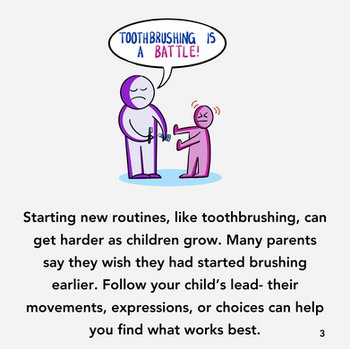
Adapting to your child's mood and energy levels
Overview
Spoon theory can help you understand your child's energy levels and adjust their toothbrushing routine to match how much energy they have each day.
What is spoon theory?
Imagine your child starts the day with a set number of “spoons,” where each spoon represents a unit of energy. This is the essence of spoon theory, a way to visualise and manage energy levels.
For example, if your child has 12 spoons to use in a day, getting out of bed might take 1 spoon. Having a bath or shower might need another 2 spoons. Getting dressed could take 1 spoon.
As the day progresses, more demanding tasks will use up more spoons. Going to school might take 3 spoons due to sensory inputs. A doctor’s appointment could use up 4 spoons because of the unfamiliar environment and potential stress.
By the end of the day, if all 12 spoons are used up, your child has no energy left for other activities. This visualisation helps in understanding why some days might be more challenging for your child and why they might need more rest or fewer activities.

How can I use spoon theory when brushing my child's teeth?
Applying spoon theory to brushing teeth can help manage your child’s energy levels more effectively. Here are some things you can consider
Think about the timing and where you brush their teeth
Some families find that brushing teeth in the bath is helpful because the water provides a calming environment that fits with their child’s mood and energy level. This can reduce the number of spoons used for this task. It may also be easier to brush teeth just after your child has participated in outdoor play or any kind of play where they have been able to move their whole body. This can help them use their energy more efficiently and might make the task less draining.
Adjusting their sensory input
You can adjust the toothbrushing environment to remove or add sensory input to either calm or engage your child, depending on what they need. For example, using a favourite toothpaste flavour or a toothbrush with a preferred texture can make the experience more pleasant and use fewer spoons. You may find this checklist helpful.
Time and space to decompress
It may helpful to give your child time and space to decompress after toothbrushing. This is especially important after a busy day or during times of the year with changes to routine. Allowing them to rest can help them regain some spoons for other activities.
Keep it positive
Remember, the goal is to make toothbrushing a positive experience. If your child becomes upset, it’s important to take a break and try again later. This approach helps conserve spoons and prevents the task from becoming too overwhelming
Links
Spoon Theory & Autism by EdPsychEd: This website discusses spoon theory in more detail and offers practical tips for parents to adapt routines, like toothbrushing, based on their child's energy levels.
Key messages

Watch again
Jump straight to what parents and early years professionals have said about different ways to build toothbrushing routines.




